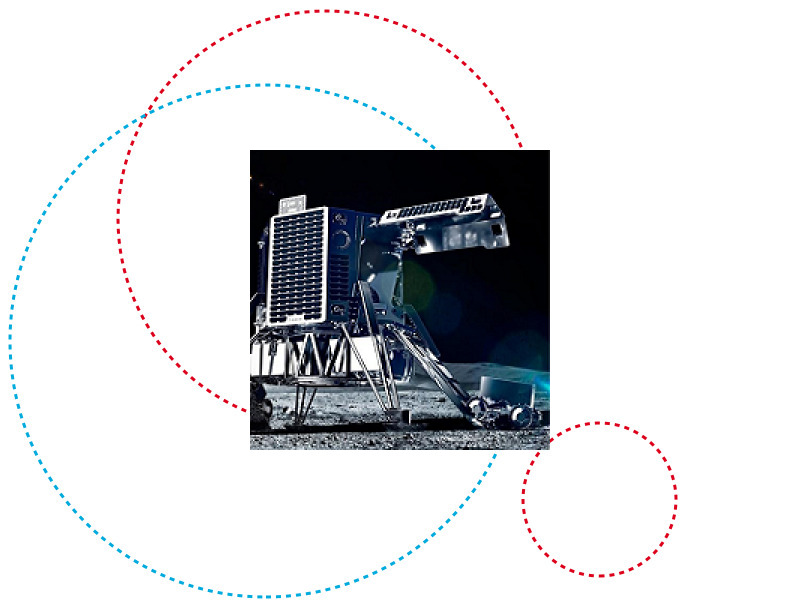Developing autonomous vehicles for use on Earth is already a major research challenge, occupying some of the brightest minds in science. Not to be outdone, a team of researchers at the University of Luxembourg and at ispace Europe are putting the problem in a lunar context.
Recent studies suggest that the Moon holds an estimated six billion tons of ice at its poles – ice that would be crucial to any further exploration of space. But challenging conditions have made these regions harder to explore even than Mars. Researchers Philippe Ludivig and Prof. Holger Voos at the University’s Interdisciplinary Centre for Security, Reliability and Trust (SnT) together with lunar robotics experts at ispace Europe are therefore developing an autonomous navigation system that can overcome these challenges and guide the ispace lunar rover through this harshest of environments.
Why an Autonomous Rover?
So far space rovers have required only a limited degree of autonomy. On Mars, for example, the long days mean that rovers can rely on solar power to survive for long missions; despite a communication delay of several minutes, remote pilots back on Earth can take their time in guiding the rover around obstacles as they appear.
Due to the length of polar nights on the Moon (one day is over 28.5 Earth-days long), a rover would require large, complex batteries to survive for more than 14 days without solar power. A weight limit of just 10kg for the ispace rover rules out this kind of hardware, so efficiency is of the essence in making the most of the rover’s short lifespan. With signals taking 2.5 seconds to get to the moon and back, this rules out remote control.

To make matters worse, current maps of the moon aren’t accurate enough for rover operations; the rover will essentially be launched into an unknown environment, and will need to be able to avoid obstacles itself and plot its own optimal course from A to B.

Credit: NASA
What are the Challenges?
To do this the rover needs sensors to take stock of its surroundings, and processors to compare this information with an internal map. The sensors need to be small, energy efficient and able to cope with extreme light conditions. The processors meanwhile have to cope with harsh radiation, and the only CPUs resilient enough for the job have poor processing power.
And because sending a rover up into space for testing isn’t an option, all the testing needs to be done here on Earth, in testing facilities, disused mines and inactive volcanoes, as well as in virtual test environments.
The images below show the ispace Europe Lunar Yard, where Ludivig is testing new techniques to teach the ispace Rover to combine data from different sensors in order to build a full 3D map of its surroundings and position itself within that map.

Black and white and 3D images taken by the lunar rover

A composite black and white and 3D image

ispace’s virtual test environment
This is all new territory, both literally and figuratively. Fortunately, Ludivig’s and SnT’s prior work on Unmanned Aerial Vehicles (UAVs) combined with ispace’s unique expertise in lunar robotics makes the team well placed to tackle the problem. UAVs share similar restrictions in weight, power and processing capabilities to space rovers, and obstacle avoidance and path planning systems have been on SnT’s radar since the Centre launched in 2009.
By 2023 this novel navigation system will be in operation, playing a key role in ispace’s ambitious programme for polar ice exploration.
Ludivig’s research is funded by the Luxembourg National Research Fund (FNR), grant 11824057.

The ispace lunar rover
About ispace
ispace is a private lunar exploration company focused on developing microrobotic systems to locate, characterise, extract, produce and deliver resources from the lunar surface to customers on the Moon and in cislunar space. The company vision is to create a sustainable ecosystem in outer space and extend humans presence throughout the solar system. To this end, the company successfully secured funding for the first two lander and rover missions and launches on Falcon 9 rockets.

SnT is turning 10! We’ve come a long way since launching our activities in 2009. Stay tuned for a year full of celebrations, cutting-edge research, and new milestones.
OVER 40 INDUSTRY PARTNERS | MORE THAN 70 EUROPEAN PROJECTS | 103 GRADUATED PHDS | 4 SPIN-OFFS
